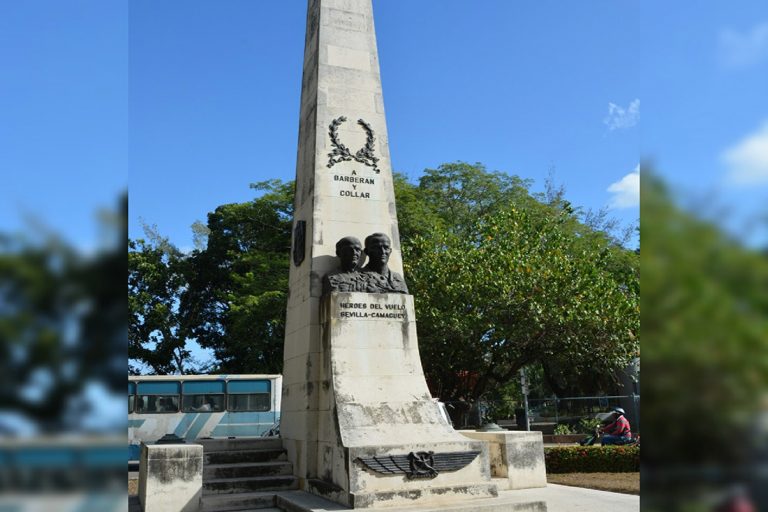On Sunday June 11th, 1933, at 3:30 in the afternoon, the city of Camagüey becomes the protagonist of an extraordinary event upon receiving the aircraft called “Cuatro Vientos”. Mariano Barberán Tros de Ilarduya as crew member and director, and the pilot, Lieutenant Joaquín Collar, had accomplished a feat: the first flight across the Atlantic Ocean from Seville, Spain, to Camagüey.
The project for this trip was presented by Barberán in October 1932 to the Spanish Government. The flight would be carried out on a Breguet XIX GR Super Bidon sesquiplane and had Modesto Madariaga as a mechanic. The President of the Government, Manuel Azaña, who is not at all an enthusiast of the expenses allocated to aeronautics, accepted the proposal and the costs of the same would be assumed, but on the condition that the plane be built entirely in Spain, as specifically stated : «Until the last screw». Its cost was 80,000 pesetas.
Barberán was an Alcarreño captain from Guadalajara who was 37 years old, had been awarded a Military Medal in the war in Africa and named a Knight of the Order of Isabel la Católica. On his side, Joaquín Collar y Serra held the rank of lieutenant and saw the light in Figueras, Gerona, he was 26 years old and was a well-known supporter of the Republic. He participated in the failed revolutionary attempt of December 1930 and, because of this, had to go into exile for a few months outside of Spain.
From Seville to Camagüey
On June 10th, 1933, loaded with 5,325 liters of gasoline and 220 of oil, they took off at 4:45 from Seville’s Tablada airport. It lands on the date and place already mentioned after traveling 4,533 miles, 7,895 km in 39 hours and 55 minutes. When they saw Cuba they only had a little more than 100 liters of fuel left, so they initially decided to land in Guantánamo, although bad weather prevented it and they chose to do so in Camagüey.
The landing was expected to be in Havana, so the city of Agramonte did not have the optimal preparation for the reception. Despite these circumstances and the rain that fell on the city, thousands of its inhabitants had climbed onto the terraces and taken to the streets to follow the arrival of the historic flight. The reception of the airmen was only attended by two aviation lieutenants, four garrison soldiers and some journalists.
After a medical examination carried out at the Military Hospital, they moved to the Hotel Camagüey. From an improvised platform, through the local CNJK radio station “La voz de Camagüey”, the Spanish pilots expressed their greetings to the Cuban people, which was broadcast throughout the country.
That night and the next morning, Barberán and Collar participated in various recreational activities, such as the welcome banquet organized by the Consul of Spain in the city, Luis Roca Togores, visits to the Sports Club, the station and the headquarters of the newspaper El Camagüeyano. In all these activities, Barberán thanked Spain again and again and Collar did not miss an opportunity to praise the women of Camagüey.
From Camaguey to Havana
On the 12th they continued their way to Havana, landing at 5:15 in the afternoon at the Columbia airfield. The reception was impressive as civil, military and ecclesiastical authorities along with a distinguished group of journalists, film operators and photographers. The days they lived in the capital were very active, full of activities and recognition of the pilots.
Havana – Mexico
On June 20th they decided to leave for Mexico at 5:55 in the morning. It was in this part of his journey that the feat turned into misery. With the weather conditions against him, at 11:45 am flying over Villahermosa, it is the last record of the plane and its crew. After the disappearance, to say the least, very painful and disconcerting, there are many hypotheses that until now do not allow us to reach a specific conclusion about the end of this unfortunate flight.
Monument
The city of Camagüey decided to perpetuate its feelings by inaugurating a monument to remember them, on January 19th, 1941, in the Enrique José Varona Park. The sculptors from Camagüey Esteban Betancourt Díaz and Servando Pita Camacho were in charge of the execution. Its realization began in June 1934 at the initiative of the radio station “La voz del Camagüey”, the Spanish Society and the city’s Chamber of Commerce.
The town also collaborated with a collection that allowed the completion of the work. Marble and bronze were used to sculpt the faces of both pilots, as well as the decorative element alluding to the feat and underneath a plaque dedicated to the heroes. With a height of 5 meters and on the sides of the column, the shields of Seville and Camagüey, this obelisk rises as a sign of the respect and admiration of the people of Camagüey for such a feat during that time and for the pilots of the memorable event.
Bibliography
Domingo, A & Fernández Coppel, J. (2003) El vuelo del Cuatro Vientos. Epopeya y tragedia de Barberán y Collar. Madrid.
Gismera Velasco, T. (2008) El vuelo del Cuatro Vientos. La última hazaña. Madrid.
Translated by: Aileen Álvarez García






